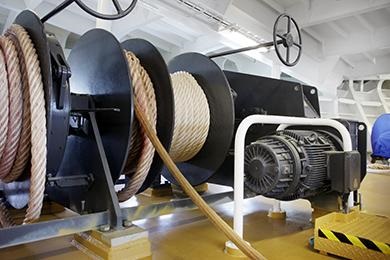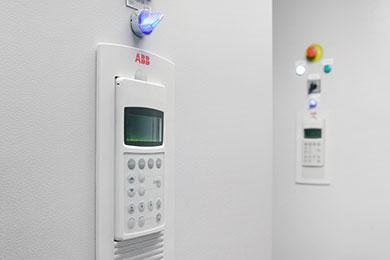“When winching up an anchor, or even a tow line, you initially have almost zero tension as it is slack at the start. Then, at the instant you hit the anchor, the torque races up and it is critically important that you have control of the enormous forces at work.”
To add to the difficulties in managing low-speed high-torque marine winches, simulating such applications is not easy so you actually need live situations. Recent research at ABB has helped to master this application, which was accomplished via close relations and teamwork with leading companies in the winching field. Among these is the Bergen-based Norwegian Deck Machinery which makes winches and other equipment for maritime vessels and the off-shore oil and gas business.

Frank Robert Fauskanger, Sales Manager Drives at ABB Norway says the benefits have been mutual. “We have been fortunate to work with NDM very closely on advanced drive control for maritime winching applications, giving mutual benefits for both parties. We started off working specifically on anchor winches and now have broadened it to numerous other maritime applications such as the Viking Line’s m/s Viking Grace ferry.”
Traditional hydraulics being replaced

Traditionally marine winches have been controlled by hydraulic systems, which have excellent dampening properties that, until recently, electrical controls had a hard time matching. However, hydraulics are often messy and complicated due to the hydraulic oil, pumps, piping and possible leaks. In addition, the maritime business, like many other older sectors, is very conservative. Thus it has not been overly enthusiastic about changing over from traditional hydraulics to the more modern electrical control.
But the change is now happening because new electronic technology has given the electrical option more precise and reliable control. Furthermore, environmental concern has also catalyzed the changeover. Hydraulic winches are becoming more controversial in the maritime business due to potential oil leaks in pristine areas such as the Barents Sea.
Drives provide precise electrical winch control

NDM has clearly seen a positive trend towards electrical winch control. “At NDM about 75% of our turnover is from winches delivered to a very wide variety of offshore maritime vessels, with a typical delivery being 5 to 6 winches per vessel. Electrical winches have grown rapidly over the past couple years and today about 50% of the winches we sell are hydraulically driven and the other 50% are electrically driven, with ABB now our preferred supplier since early 2011.
”The key benefits electrical systems give users come from ABB’s winch control software which is specifically programed for winch applications. This gives it true plug and play simplicity, explains Jarle.
“We simply enter a few parameters and then start it up. Most times it is spot on and works perfectly the first time. Of course from time to time we have some special situations so we need to make a couple changes in the parameters, but then it is running very well.

“Actually we initially started with another brand of frequency converter, but we were not entirely satisfied. At the same time we heard that ABB had developed new winch software which was working well in this challenging application. Now we are only using ABB, and sometimes our customers even put it on their purchase specification that it must be ABB frequency converters."
Viking Grace was 1st ferry project for NDM
The Viking Line ferry m/s Viking Grace was an interesting case for NDM since it was the first time they worked on a ferry project. The Viking line ferry goes daily between Sweden and Finland, making a short stop in the Åland Islands.
The very short time in harbor requires very precise and rapid winch control, continues Jarle. “So we had to speed up the winches which was very simple with the ABB frequency converter. We also used the electrical solution for the big anchor on the Grace. That helped us enter another sector where we are controlling large anchor winches which we had not done before.
“These requirements meant that the Viking Line project involved many new challenges for us, especially the high speeds on the winches because they have quick turnaround times. All the special requirements that the ferry operator had, such as precise tension control and higher speeds were easy for us to accommodate simply by changing a couple parameters in the easy-to-use software.”
Superb force control without the hassle
Force control is a key issue where hydraulic was better in the past than electrical. But now with the ABB solution, electrical force control is as good as or even better than hydraulic. “When the market saw how well electrical worked, they began to require it due to its superior convenience,” says Frank Robert. “It only needs an electrical cable, compared with the hydraulic pumps and piping as well as the risk of oil leaks. The environmental risks are making the electrical solution preferred in the Arctic area up north, and we see the requirement for electrical winching rising as there is more oil being discovered in the Arctic.”
Jarle concludes the discussion about electric winch control as follows: “We see a very interesting future both in the offshore business, which we have worked in for many years, as well as the new ferry business where these applications are very well suited. For us it’s very important to have ABB on our team, so we can together further develop even more complex winches. Using our market knowledge and contacts, combined with their expertise in frequency converters, we are doing continuous technical development together. We have seen positive benefits of working with the ABB frequency converter. When we put it on the equipment, we know it’s working. When supplying winches to a vessel the deadlines are very strict, meaning it must leave the yard on the day it is supposed to. We must be sure that when they want to start the winches, they are starting. In addition, we save time, money and hassle by knowing that the electrically-driven winch will start right the first time and our customer will be satisfied and be able to meet his deadline.”